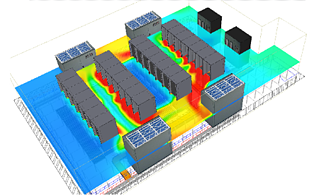3 Ways Data Centers Can Use CFD Modeling Right Now
You may have heard about computational fluid dynamics (CFD) modeling when it comes to the design of high-performance Formula 1 racecars. By using CFD modeling to maximize down-flow forces while minimizing friction – for the racecar body and smaller “wings and struts” – Formula 1 produces a winning combination.
In a similar manner, CFD can be used in today’s data centers during design, capacity planning, troubleshooting and day-to-day operations. It can be used to properly develop the best design and operations solutions throughout the entire data center ecosystem, from the micro environment (chips) to enclosure environments (cabinets and containment) to the macro environment (computer white space and the entire data center hall).
Here are three ways that your data center ecosystem can benefit from CFD.
1. Server Design and CFD Modeling
High-efficiency server manufacturers are pushing the limit on power efficiency and thermal boundaries. They use CFD modeling to optimize power and thermal characteristics.

A typical high-performance server is made up of precisely located components to optimize performance and efficiency: CPU, motherboard, power supply, CPU, storage, drives, fans, heat sinks and other components. To assist the design engineer in arranging these components to meet design objectives and maximize power and thermal goals, CFD modeling is used.
It provides a tool to virtually test a server in different configurations, taking into account different enclosure and cooling configurations, such as cold-aisle containment, hot-aisle containment, overhead supply, underfloor supply and rack-centered cooling solutions.
This technology can fine tune thermal characteristics of a server and provide a more accurate power/thermal baseline. Data center designers then use this information to develop the most efficient data center cooling solution possible.
Today's CFD analysis tools can also coordinate the server, rack and data center hall to take full advantage of accurate server data to develop precise, energy-efficient enclosure/containment and high-performance cooling solutions.
CFD modeling can be used by design teams to test innovative cooling strategies as well. For example, it helps them better understand how liquid cooling technologies and cold plate options impact server performance.
2. Enclosure Design and CFD Modeling
Today, optimized enclosure solutions are necessary to accommodate growth in data center capacity and increased power density due to the explosion of cloud solutions and the escalation of IoT and AI.
CFD analysis provides flexibility for data center design teams to swap server models (and associated CFD results data) so they can simulate the answers to certain questions. For example, CFD analysis tells you whether a cabinet can respond to a swing in equipment power density from 5 kW to 15 kW.
Compared to designers having to use nameplate data or a “black box,” accurate results from CFD models of server equipment give designers the best data foundation possible to virtually push the capacity limits of an enclosure to obtain more capacity while following thermal guidelines from SLAs and ASHRAE.
3. Facility Design and CFD Modeling
Data center facilities engineering teams responsible for developing mechanical cooling strategies can benefit significantly from incorporating server and enclosure CFD modeling results into a CFD model of the data center hall.
Accurate temperature, pressure and airflow results from server and enclosure models can be used to develop a fine-tuned mechanical system design strategy (from chiller plant, pump selection and piping/valve selections to CRAC size and number, ductwork size, raised floor depth and control) that is correctly sized to accommodate Day 1 and Day 2 server loads.
A right-sized mechanical system offers several benefits:
- Reduced energy consumption
- Lower PUE (power usage effectiveness)
- Smaller mechanical footprint
- A mechanical system tuned directly to server loads
This results in enhanced server SLA compliance, reduced hotspots and a more efficient server.
How Belden Uses CFD
Belden uses CFD modeling to assist data center design professionals, managers and operators in designing efficient technology solutions for new and legacy data center environments.
CFD analysis provides predictive results that bridge high-performance computer server operations with the rack enclosure, and with the critical mechanical system.
Just as a fine-tuned Formula 1 racecar relies on highly trained engineers to develop the most efficient racecar possible, today’s high-performance data center operators can rely on Belden to do just the same: use highly trained engineers to develop an efficient solution that reduces costs, ensures uptime, maximizes space and saves times. Learn more here.
![System.String[]](https://assets.belden.com/transform/ceb14c58-fa1f-4197-9348-b51087c9e2e9/dan-bodenski?io=transform:fill,width:300,height:300)